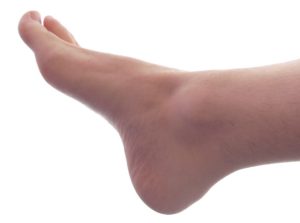Lisfranc injuries occur at the Lisfranc joint at the midfoot, where the metatarsals (long bones of the foot) connect to the tarsal bones, namely the cuboid and the three cuneiforms (medial, intermediate and lateral). The bones at the Lisfranc joint are connected by tough ligament bands that ensure correct alignment and good strength through these midfoot joints. This is vital for arch stability and for walking. Injuries at the Lisfranc joint can come in the form of sprains, fractures of dislocations.
 Lisfranc injuries result from overloading the midfoot, which often occurs through either the twisting of the foot of from
impact to the midfoot. This tears the supporting ligaments and can dislocate or fracture a bone. Anything that twists and overloads the
midfoot can cause a Lisfranc injury, examples include:
Lisfranc injuries result from overloading the midfoot, which often occurs through either the twisting of the foot of from
impact to the midfoot. This tears the supporting ligaments and can dislocate or fracture a bone. Anything that twists and overloads the
midfoot can cause a Lisfranc injury, examples include:
Symptoms include:
The first step is to alleviate the painful symptoms. This can be done following the PRICE (protection, rest, ice, compression, elevation) principles. Treatment will then depend on the severity of the injury and whether a ligament sprain, fracture or dislocation has occurred. It should be noted that midfoot sprains take significantly longer to heal than regular ankle sprains. Because the midfoot takes on 2-3 time a person’s body weight on standing, reducing this pressure and minimising weight-bearing at the midfoot is a key part of treatment. Your GP and podiatrist will work together to effectively manage your injury. Severe injuries may require surgical intervention. Conservative treatments can include:
.png)
Since introducing shockwave therapy, we’ve helped many of our patients avoid surgery for certain conditions. Here's what you
need to know about shockwave treatment and how it works.
.png)
This Mother’s Day, consider a practical, medically safe, and confidence-boosting gift: a professional KeryFlex nail restoration treatment. It’s a simple, effective, and medically safe way to instantly transform the appearance of toenails.
Keeping your family on their feet and helping them to walk, run, play and exceed their goals is why we love getting up in the morning.
Ground Floor, One Health Building
122 Remuera Rd, Remuera
Auckland 1050, New Zealand
| MON - FRI | 7:30am – 6:30pm |
| SAT | 8:30am – 4:30pm |
| SUN | Some availability |
Make an Appointment
Online Schedule